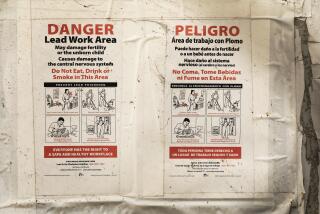Agency moves toward stricter ban on lead in kids’ jewelry
WASHINGTON — A government regulatory agency has taken steps toward banning children’s jewelry containing small amounts of lead, which was responsible for more than a dozen product recalls in the last two years.
The Consumer Product Safety Commission voted Wednesday to move forward in a process that could result in a ban on children’s jewelry containing more than 0.06% lead by weight.
“Our goal is not to continue to do recall after recall,” commission spokesman Scott Wolfson said. “We’ve had upwards of 14 recalls since 2004.”
The commission works with companies to issue recalls when it finds consumer goods that can be harmful. Under current regulations, children’s products found to have more than 0.06% lead are usually subject to a recall, in which the company must reimburse consumers for the value of the product, provide a replacement or offer a repair.
In March, a Minnesota boy died of lead poisoning after swallowing a pendant from a charm bracelet that came with a pair of Reebok shoes. The incident resulted in a recall. In 2004, the commission issued the biggest recall in the agency’s history: 150 million pieces of children’s jewelry with unsafe lead levels.
This month the agency’s staff urged commissioners to evaluate safety of children’s jewelry by total lead content and ban anything with more than 0.06% lead by weight.
Since February 2005, children’s jewelry has been evaluated on total lead content and on the percentage of lead considered “accessible” to children. But the accessibility of lead was the agency’s primary safety concern. The proposed rule change would eliminate tests for accessible lead and judge safety solely on total lead content.
“Where you have high levels of total lead you generally have high levels of accessible lead also,” Wolfson said. “So let’s streamline the process.”
By banning toy jewelry with that much lead, Wolfson said, the agency can fine companies that knowingly manufacture, sell or import it.
The commission will be gathering public comment on the proposed rule in the coming months.
More to Read
Sign up for Essential California
The most important California stories and recommendations in your inbox every morning.
You may occasionally receive promotional content from the Los Angeles Times.










